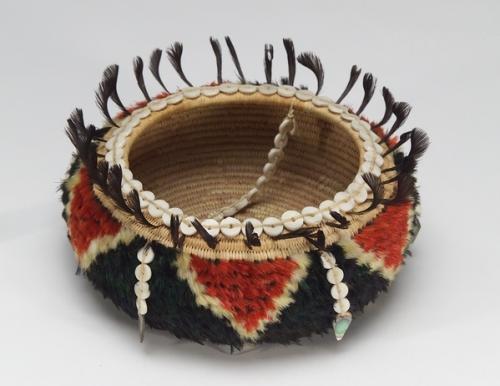
Susie Billy (Hopland Band Pomo/Kashaya Pomo, ca. 1885–1968), basket bowl. 1950–52, Hopland Reservation, Mendocino County, California. Willow, quail feathers, mallard duck feathers, woodpecker feathers, shell beads, cotton string; 7.8 x 15.6 cm. Purchased from Elsie Allen (Pomo, 1899–1990) by Indian Arts and Crafts Board representatives in 1952. Indian Arts and Crafts Board Collection, Department of the Interior, at the National Museum of the American Indian, Smithsonian Institution. NMAI 26/0
The Indian Arts and Crafts Board (IACB) Collection has few artworks from California, especially basketry. The agency did purchase nine baskets in 1952 from the Pomo Indian Women’s Club. The baskets are from Karuk, Mono, Pomo, Washoe, and Yurok basket makers. Two of the nine baskets are missing and were not transferred to the National Museum of the American Indian in 2000.
Renowned Pomo basket maker Susie Billy (ca. 1885–1968) made this feather basket in the early 1950s and included the following information: “The feather basket I am sending is a round basket 7 inches across on top… . The material used is white willow reed which is gathered in fall of the year when the willow is in a dormant stage… . The green feathers are male mallard duck head feather, the red feathers are wood chuck head feather … the cream-colored feathers are wood chuck throat feather… . The bead is made by hand work out of Washington clam … and on the end of the hanging bead is abalone shell … .”
The Pomo Indian Women’s Club of Ukiah, California—originally called the Pomo Mothers Club—operated from 1940 to 1957. It brought together basket makers in a social setting while establishing fair prices for their work. The club also became a vehicle for educational and cultural outreach, countering anti-Indian discrimination in California. In many towns in the state, Native children could not attend school with white children, and there were segregated movie theaters and restaurants (see, for example, the lawsuits brought forth by Steven Knight [Yokayo] in Mendocino County).
The Pomo Indian Women’s Club held displays and exhibitions of California Indian basketry. At these events, the members would demonstrate basketry, answer questions, and explain Pomo culture. In 1943, the club mounted the exhibition Contemporary Basketry of the Pomo Indians of California at the San Francisco Museum of Art (now the San Francisco Museum of Modern Art).
The IACB added the club to its published directory of Native arts and crafts associations, but the basket makers couldn’t keep up with the demand for their work. In 1955, basket maker and club treasurer Elsie Allen wrote to the board to say, “Our weavers are very few. We cannot meet the order. Please cancel the Pomo Women’s Club [from the] list.”
More information about the Pomo Indian Women’s Club can be found in Remember Your Relations: The Elsie Allen Baskets, Family and Friends by Susan Abel–Vidor, Dot Brovarney, and Susan Billy (Heyday Books). An excerpt from a 1980 interview with Elsie Allen is available online courtesy of the Ya-Ka-Ama Media Project.
Susie Billy’s description of her basket and Elsie Allen’s note to the IACB are from documentation that accompanied the Pomo Indian Women’s Club baskets when they were transferred to the museum.
—Anya Montiel